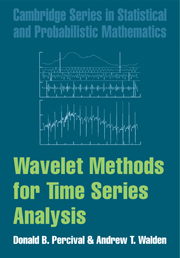Refine search
Actions for selected content:
2703 results in General statistics and probability
8 - Flow level Internet models
-
- Book:
- Stochastic Networks
- Published online:
- 05 June 2014
- Print publication:
- 27 February 2014, pp 186-200
-
- Chapter
- Export citation
7 - Internet congestion control
-
- Book:
- Stochastic Networks
- Published online:
- 05 June 2014
- Print publication:
- 27 February 2014, pp 151-185
-
- Chapter
- Export citation
References
-
- Book:
- The Skew-Normal and Related Families
- Published online:
- 18 December 2013
- Print publication:
- 19 December 2013, pp 241-255
-
- Chapter
- Export citation
1 - Modulation of symmetric densities
-
- Book:
- The Skew-Normal and Related Families
- Published online:
- 18 December 2013
- Print publication:
- 19 December 2013, pp 1-23
-
- Chapter
- Export citation
8 - Application-oriented work
-
- Book:
- The Skew-Normal and Related Families
- Published online:
- 18 December 2013
- Print publication:
- 19 December 2013, pp 215-229
-
- Chapter
- Export citation
Preface
-
- Book:
- The Skew-Normal and Related Families
- Published online:
- 18 December 2013
- Print publication:
- 19 December 2013, pp vii-viii
-
- Chapter
- Export citation
Appendix B - Complements on the normal distribution
-
- Book:
- The Skew-Normal and Related Families
- Published online:
- 18 December 2013
- Print publication:
- 19 December 2013, pp 232-236
-
- Chapter
- Export citation
3 - The skew-normal distribution: statistics
-
- Book:
- The Skew-Normal and Related Families
- Published online:
- 18 December 2013
- Print publication:
- 19 December 2013, pp 57-94
-
- Chapter
- Export citation
2 - The skew-normal distribution: probability
-
- Book:
- The Skew-Normal and Related Families
- Published online:
- 18 December 2013
- Print publication:
- 19 December 2013, pp 24-56
-
- Chapter
- Export citation
Index
-
- Book:
- The Skew-Normal and Related Families
- Published online:
- 18 December 2013
- Print publication:
- 19 December 2013, pp 256-262
-
- Chapter
- Export citation
4 - Heavy and adaptive tails
-
- Book:
- The Skew-Normal and Related Families
- Published online:
- 18 December 2013
- Print publication:
- 19 December 2013, pp 95-123
-
- Chapter
- Export citation
Appendix C - Notions on likelihood inference
-
- Book:
- The Skew-Normal and Related Families
- Published online:
- 18 December 2013
- Print publication:
- 19 December 2013, pp 237-240
-
- Chapter
- Export citation
Appendix A - Main symbols and notation
-
- Book:
- The Skew-Normal and Related Families
- Published online:
- 18 December 2013
- Print publication:
- 19 December 2013, pp 230-231
-
- Chapter
- Export citation
Contents
-
- Book:
- The Skew-Normal and Related Families
- Published online:
- 18 December 2013
- Print publication:
- 19 December 2013, pp v-vi
-
- Chapter
- Export citation
6 - Skew-elliptical distributions
-
- Book:
- The Skew-Normal and Related Families
- Published online:
- 18 December 2013
- Print publication:
- 19 December 2013, pp 168-195
-
- Chapter
- Export citation
5 - The multivariate skew-normal distribution
-
- Book:
- The Skew-Normal and Related Families
- Published online:
- 18 December 2013
- Print publication:
- 19 December 2013, pp 124-167
-
- Chapter
- Export citation
Frontmatter
-
- Book:
- The Skew-Normal and Related Families
- Published online:
- 18 December 2013
- Print publication:
- 19 December 2013, pp i-iv
-
- Chapter
- Export citation
7 - Further extensions and other directions
-
- Book:
- The Skew-Normal and Related Families
- Published online:
- 18 December 2013
- Print publication:
- 19 December 2013, pp 196-214
-
- Chapter
- Export citation

The Skew-Normal and Related Families
-
- Published online:
- 18 December 2013
- Print publication:
- 19 December 2013

Wavelet Methods for Time Series Analysis
-
- Published online:
- 05 December 2013
- Print publication:
- 24 July 2000
